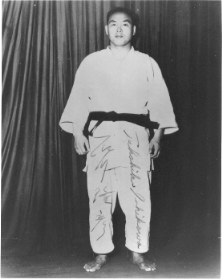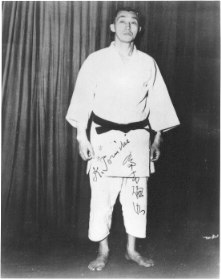
Editor's note: The most accessible source of information about the US Air Force's judo program of the 1950s and 1960s is "Judo in the Armed Forces" by Lt. Agulla Gibbs Dibrell" in John Corcoran and Emil Farkas, Martial Arts: Traditions, History, People (New York: Gallery Books, 1988), 228-229. (Ignore the surrounding drivels written by Dennis Helm; this section's actually pretty good.)
Nevertheless, the US Air Force judo program is today essentially forgotten, which is too bad, as it is one of the chief reasons behind the mainstreaming of Japanese martial arts in the United States following World War II. So, toward encouraging further research into this subject, the following are some contemporary descriptions of the Strategic Air Command judo tour of 1953.
The accompanying photographs are courtesy of the Strategic Air Command
Museum in Bellevue, Nebraska. People with additional stories, photos, or
clippings are invited to contact the editor at jrsvinth@juno.com.
American Commentary
By Robert W. Smith
From the Budokwai Quarterly Bulletin, October 1953, page 13. Copyright © 1953 by the Budokwai, London, England; reprinted by kind permission of the Budokwai.
Summer, which ordinarily passes for a slack judo season, has not been exactly that this year. Interest has been heightened and retained at a high pitch in the U.S. due largely to the efforts of the Kodokan 10 man team which is visiting the chief Strategic [Air Command] Air Force bases in this country. The team is composed of the following experts in judo, karate, and aikido:
Sumiyuki Kotani
Tadao Otaki
Chugo Sato
Takahiko Ishikawa

Kenji Tomiki
Kiyoshi Kobayashi
Hidetaka Nishiyama
Kusuo Hosakawa
Isao Obata
Toshio Kamada
I have been unable to see them but may be able
to do so before September 12th, the date they return to Japan.
I have received some information regarding their exhibitions and training
sessions. It would seem that they are stressing functional judo, as the
combat aspects of karate and aikijutsu are being emphasised. Nishiyama,
one of the highest graded karate men in Japan, splits two-inch boards with
his feet and hands while Tomiki pushes, pulls, and twists multiple opponents
in his incomparable demonstrations of aikido. Judo, however, is not neglected.
One report has Ishikawa (7th Dan), 1950 All Japan Champ, dropping
six yudansha in 30 seconds; the mechanics of the art are ably demonstrated;
and Kotani (8th Dan), even allows himself to be thrown by seven-year-old
Alan Damron at the Castle Air Force Base in California.
"Judo Fighters Perform Here," Spokane Bomber Views, June 26, 1953, 3.
A group of the world's leading exponents of the art of Judo and self-defense demonstrated their skill at Fairchild [Air Force Base, Spokane, Washington] on Sunday and Monday before large groups of military and civilian personnel.
The group is touring the Strategic Air Command installations primarily to demonstrate the art of hand to hand combat to air crews, however the public was invited to the Sunday afternoon performance and all base personnel were invited to attend the Monday programs.
Included with the group as it tours the country are Mr. Mel Bruno, Strategic Air Command physical conditioning supervisor and A/1CL [Airman First Class] Leo Paulin, a first degree black belt holder. Mr. Bruno is in charge of the group and Airman Paulin is assigned to assist Mr. Bruno on the tour.

A tense situation occurred during the Monday morning demonstrations. Mr. Bruno, using a Fairchild airman as an aid in his instructions, found his aid to be an adversary rather than an assistant.
Realizing the aggressive intent by the airman,
Mr. Bruno proceeded to put him to sleep with a pressure squeeze on his
neck. The airman was only too happy to cooperate after being revived.